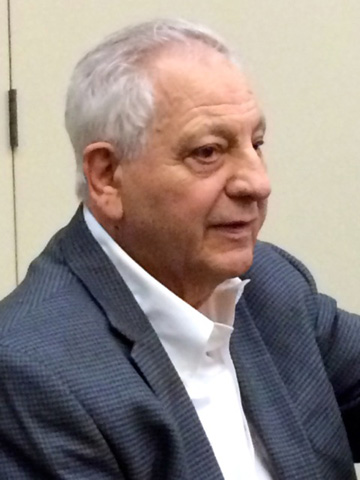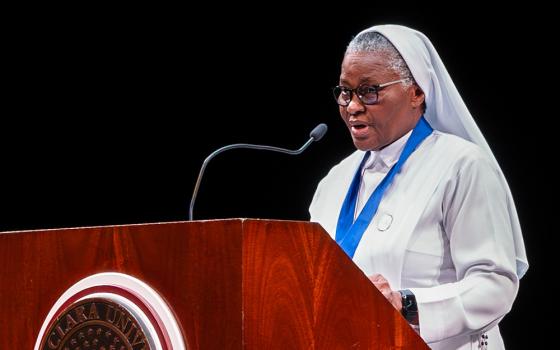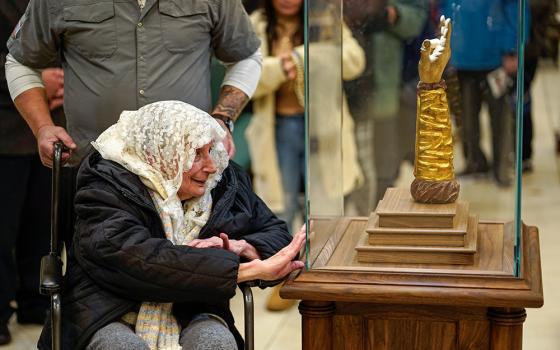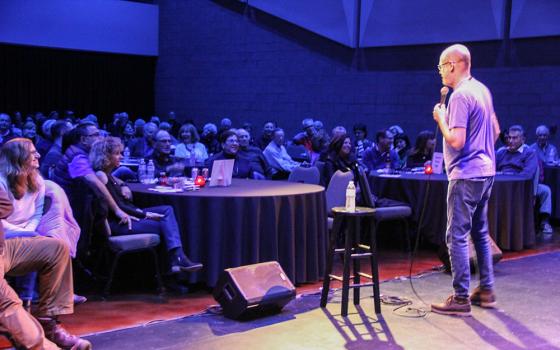
Henry Louis D'Arienzo, 90
Henry Louis D'Arienzo
Age: 90
Who he is: Sister Camille's cousin, member of the St. Vincent de Paul Society
Lives in: Leesburg, Va.
Sr. Camille: Lou, your last name reveals you as my relative. I've long been proud to claim you as a cousin and now would like our readers to know why. I'd like to start by asking you to explain how we are related.
D'Arienzo: We are related through our fathers, who were brothers.
Please tell us about the family in which you group up. How many were in it?
As I remember, there were four of us for some time, but it varied over time. At first, there was my mother, father, a sister and a brother, Anthony. My oldest brother, John, was out of the house. My mother, Filomena D'Arienzo, died when I was young, in 1931. My father was Anthony, who died in 1955. My stepmother was Meta Fisher. My oldest brother was John (1907-1998). There was 17 years difference in our ages. Next was another brother, Louis (1908-1919, born Luigi), who died when he was young, before I was born. My next sibling was my sister, Joann, known as Ann (1915-1966). Next came my brother Anthony (1918-2013). Then I was born on Dec. 1, 1924 -- the youngest child, named Henry Louis after my brother and my father's brother, your father.
Where did you live?
When I was very young, we lived at 138th Street, South Ozone Park, Queens. But we moved many times from age 6 to 11 after my mother died. When I was 11, my father remarried, and we moved to 69-18 Nansen Street, Forest Hills, Queens, which was my stepmother Meta's house. Her grandmother and her unmarried brother, William, were part of the household.
Where did you go to school?
I attended five elementary schools from ages 6 to 11 in various parts of Queens. At 11, I entered PS 144, graduating in 1939. From 1939 to 1943, I attended Grover Cleveland High School in Ridgewood, Queens. Then I joined the Marines and was in World War II in the Pacific and Japan.
Did you have any role models or heroes?
Unlike many, I did not have any role models or the like. I sort of grew up like a weed.
Where and when did you meet your wife, Joan?
When we moved to Forest Hills and entered the sixth grade at PS 144, Joan was a member of the class. We both went to Grover Cleveland High School and graduated together in June 1943 So, I have known her for 79 years.
What is she like?
Joan is one of the smartest people I have ever met. She loves people and is great to be with. Her one regret is that she has not traveled the world as much as she would have liked to. But she has traveled a great deal, not only to Europe, including Italy, Spain, England and Scotland, but also to the far states of Hawaii and Alaska. And she went even farther -- to China, Hong Kong, Australia, New Zealand. She went to all the exotic places with her sister, Eileen. I stayed home and worked.
Please name and briefly describe your children.
God gave Joan and me four wonderful daughters. They are Daria (born in 1954), Lydia (1955-1998), Cyria (born in 1961) and Fabia (born in 1963). They were like two sets. Daria and Lydia were 13 months apart. Then eight years later, Cyria and Fabia were born 15 months apart.
Lydia died of cancer when she was 42. All during her growing years and into adulthood, she was a ballet dancer, dancing seven days a week. As a young woman, she was training to become a professional. She is the mother of my oldest grandson, Kris.
All the girls, except Lydia, went to college and got advanced degrees. My three surviving daughters are all married to wonderful men. Cyria lives in Scotland with her husband, Alasdair.
Fabia and her husband, Sohrab, have two wonderful children: my grandson Bijan, who is 14, and my only granddaughter, Jeela, who turned 17 on Jan. 2.
What was your profession before retiring?
Before I retired, I was employed as a sales representative and sales manager at a small insurance agency with offices on William Street in the Financial District of New York City. The company specialized in all types of coverage for the medical and dental professions and hospitals in New York (city and state), Long Island, and New Jersey area.
What is your connection with the St. Vincent de Paul Society?
I have been a Vincentian 53 years. There is a story behind the way I became a Vincentian. It was a Saturday afternoon in 1961. I was standing in line, waiting to give blood. I was in the basement of the Saks department store in the Mayfair Shopping Center in Commack, on Long Island. While in line, Fr. Anthony J. Foley, the pastor of the new Christ the King parish, tapped me on the shoulder and said: "You will be at the rectory Monday night at 8 p.m." So of course I went because no one disobeyed a priest.
That Monday night, Father Foley and the 12 men he selected the same way formed the Christ the King Conference of the Society of St. Vincent de Paul, which continues to this day.
The St. Vincent de Paul has been my life.
It is here, at the parish conference level, where the real St. Vincent de Paul work is done. The Vincentians work in pairs and visit the poor and needy in God's name. We believe we show the face of the Lord on all whom we serve. I am only a representative of the more than 70,000 Vincentians in the United States and the hundreds of thousands throughout the world.
As an important aside, I might add that for the first 85 years, the St. Vincent de Paul was a men-only organization. But in 1968, women were presented to join, and it was the best thing that ever happened. Today, more than half the members are women. Women were able to relate with female clients and offered another perspective on service. Today, whenever the person or family that needs help includes a woman, the St. Vincent team visiting for assistance is made up both a male and a female Vincentian.
What did you have to offer that organization?
I think my main contribution to the St. Vincent de Paul was to serve the poor with love and dignity. And a willingness to work at whatever was needed.
I am now a retired member of the Christ the King Conference of Society of St. Vincent de Paul.
During the 50-plus years I was active, I held various positions in the society. For six years, I was president of the Society for Rockville Center on Long Island.
I was also active at the national level, working with the main society office in St. Louis. For six years, I was the head of the national Stores Committee. (The St. Vincent stores, stocked with donated items, offer a means to provide clothing, furniture, household and other items to those in need. They also provide the society with income to support its broad-based work.) I also served on the national Finance Committee for 12 years.
I am only like all the many thousands of Vincentians in the U.S. and worldwide -- where the volunteers at the conference level do the real work. I am no different or better than any other Vincentian. The only difference was that like some others, I did take on a few leadership jobs in the society when needed. But though I served somewhat beyond the local conference, my very real work was in the local conference working directly with those we served. It is the biggest and most important part of being a Vincentian.
What benefits did you take from that involvement?
Being a Vincentian made me understand that there were many poor among us. I realized that the poor and those in need did not bring it on themselves in most cases, as people accuse them of. I also realized: "There but for the grace of God go I."
Can you share a particular memory that convinced you of the need of St. Vincent de Paul Society?
While many of the society's local conference cases to help those in need are the same, there are some that are vastly different. I would not want to speak of any one case in particular. But in all my years as a Vincentian, I learned that many people and whole families live from paycheck to paycheck, and if something unexpected happens or an unforeseen bill comes due, that single thing can devastate a family and they can no longer make ends meet.
Once I became a Vincentian -- and only then -- did I find out that there are more people than you think in need who are not "seen" -- and in many cases, they suffer in silence. Because of the work we do, this is something all Vincentians know.
Why did you move from Long Island?
We moved in December 2011 to be closer to our grandchildren.
How are you spending your retirement?
Helping my family; spending time with my grandchildren; writing stories, which often feature the St. Vincent de Paul as part of the context or story line (they are not necessarily good stories -- but they are short); reading large-print books; keeping connected to the Bethpage office of the society and supporting the whole society as I can; participating in the Leisure World activities and visiting with neighbors; attending Leisure World events that support those in need in the local community; joined the Torch Club and go to their monthly dinners and talks; and I've taken an interest in the young people who work in the complex. And like everyone else, I go to the doctor (which seems endless!), watch TV, and nap even when I am supposed to be doing something else!
Where and with whom do you worship?
There are two nearby churches: St. John the Apostle in Leesburg and St. Theresa Church in Ashburn. On Sundays, there is an 8 a.m. van to take residents to the 9 a.m. Mass at St. Theresa Church.
How do you pray?
I use the Little Books created by Bishop Ken Untener for daily prayer for Advent and Christmas, Lent, Easter, stewardship and more from the diocese of Saginaw, Mich. I read the lessons and the Scripture passages every day. And I say a lot of silent prayers.
How do you think of God?
I guess I think of God as the one who watches over all of us at all times and the one we go to for help and give thanks to at various times in our lives. And in my case, I speak to God many times during the day and night. If I wake up from a sound sleep, I say, "Thank you, God" one more time.
Does any Scripture passage hold particular attraction for you? If so, please explain which one it is and why it does.
I believe the one Scripture passage I relate to the most is the Good Samaritan, which is closely related to the Society of St. Vincent de Paul's works -- help given to someone without looking for something in return, just given out of love.
What do you want from Catholicism?
I believe as a Catholic, I would want us to have more respect and better understanding of others who are not Catholics and how they worship their god. Being a Catholic does not automatically make you a good person. Not being a Catholic does not automatically make you a bad person. It is how you live your life that matters -- respect and love for others and God.
Is there anything in it you would change?
I wish that every parish would have and support a St. Vincent de Paul conference and have fewer "business managers" and more people-to-people volunteers.
I hope that someday, the Catholic church leaders will realize that we live in a new century. So our thinking in many ways must change without changing our belief in God and all his works. For our leaders, from the pope on down, this has to do with the questions of married priests and female clergy, for starters, and the unspoken and unthinkable topic, birth control.
What else would you like us to know?
I would like to acknowledge some of the wonderful people I have met in my years as a Vincentian. They are good people.
And I would say to everyone: "What would you do if you had no place to sleep tonight? If you had no food to feed your children? And if you could only believe that tomorrow would be as bad or worse than today?"
In my 50-plus years with the St. Vincent de Paul Society, I have found that many families we see as Vincentians are only a paycheck away from that situation.
So please do not forget to pray for those in need and to thank God for what you have and remember to share it in some way with those in need.
[Mercy Sr. Camille D'Arienzo, broadcaster and author, narrates Stories of Forgiveness, a book about people whose experiences have caused them to consider the possibilities of extending or accepting forgiveness. The audiobook, renamed Forgiveness: Stories of Redemption, is available from Now You Know Media.]
Editor's note: We can send you an email alert every time Sr. Camille's column, Conversations with Sr. Camille, is posted. Go to this page and follow directions: Email alert signup.



